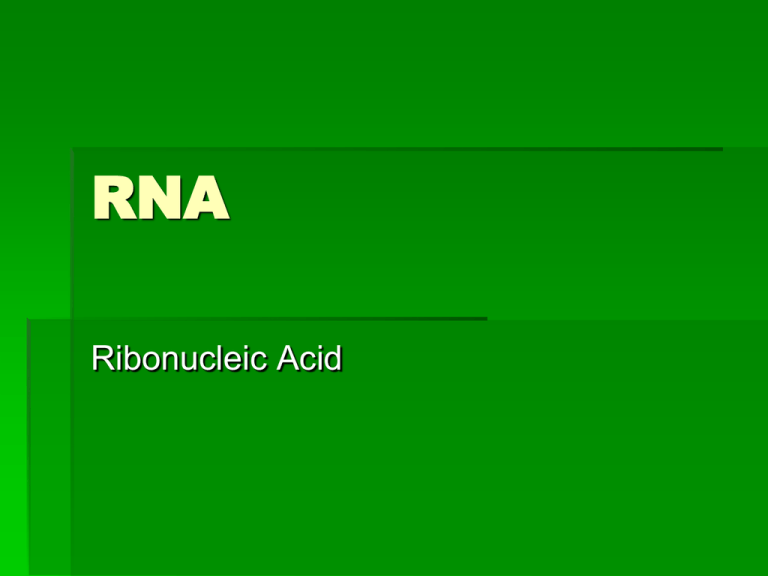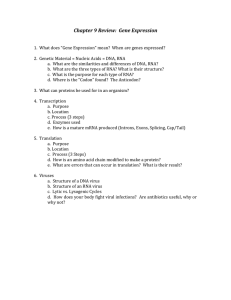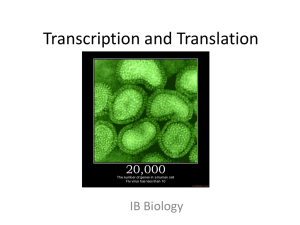RNA Ribonucleic Acid
advertisement

RNA Ribonucleic Acid Ribonucleic Acid (RNA) RNA is much more abundant than DNA There are several important differences between RNA and DNA: - the pentose sugar in RNA is ribose, in DNA it’s deoxyribose - in RNA, uracil replaces the base thymine (U pairs with A) - RNA is single stranded while DNA is double stranded - RNA molecules are much smaller than DNA molecules) Structure of RNA Single stranded Ribose Sugar 5 carbon sugar Phosphate group Adenine, Uracil, Cytosine, Guanine Types of RNA Three main types Messenger RNA (mRNA) – transfers DNA code to ribosomes for translation. Transfer RNA (tRNA) – brings amino acids to ribosomes for protein synthesis. Ribosomal RNA (rRNA) – Ribosomes are made of rRNA and protein. Transcription RNA molecules are produced by copying part of the nucleotide sequence of DNA into complementary sequence in RNA, a process called transcription. During transcription, RNA polymerase binds to DNA and separates the DNA strands. RNA polymerase then uses one strand of DNA as a template from which nucleotides are assembled into a strand of mRNA. mRNA How Does it Work? RNA Polymerase looks for a region on the DNA known as a promoter, where it binds and begins transcription. RNA strands are then edited. Some parts are removed (introns) - which are not expressed – and other that are left are called exons or expressed genes. The Genetic Code This is the language of mRNA. Based on the 4 bases of mRNA. “Words” are 3 RNA sequences called codons. The strand aaacguucgccc would be separated as aaa-cgu-ucg-ccc the amino acids would then be Lysine – Arginine – Serine - Proline Genetic Codes Translation During translation, the cell uses information from messenger RNA to produce proteins. A – Transcription occurs in nucleus. B – mRNA moves to the cytoplasm then to the ribosomes. tRNA “read” the mRNA and obtain the amino acid coded for. C – Ribosomes attach amino acids together forming a polypeptide chain. D – Polypeptide chain keeps growing until a stop codon is reached. Protein Synthesis The two main processes involved in protein synthesis are - the formation of mRNA from DNA (transcription) - the conversion by tRNA to protein at the ribosome (translation) Transcription takes place in the nucleus, while translation takes place in the cytoplasm Genetic information is transcribed to form mRNA much the same way it is replicated during cell division Translation to Protein Mutations Gene mutations result from changes in a single gene. Chromosomal mutations involve changes whole chromosomes. Gene Mutation Point Mutation – Affect one nucleotide thus occurring at a single point on the gene. Usually one nucleotide is substituted for another nucleotide. Frameshift Mutation – Inserting an extra nucleotide or deleting a nucleotide causes the entire code to “shift”. Gene Mutation Chromosomal Mutations Deletion – Part of a chromosome is deleted Duplication – part of a chromosome is duplicated Inversion – chromosome twists and inverts the code. Translocation – Genetic information is traded between nonhomologous chromosomes. Chromosomal Mutations Mutations More Mutations Gene Regulation In simple cells (prokaryotic) lac genes which are controlled by stimuli, turn genes on and off. In complex cells (eukaryotic) this process is not as simple. Promoter sequences regulate gene operation. Review




